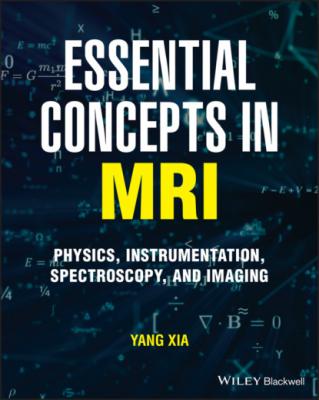Essential Concepts in MRI. Yang Xia
Читать онлайн.| Название | Essential Concepts in MRI |
|---|---|
| Автор произведения | Yang Xia |
| Жанр | Медицина |
| Серия | |
| Издательство | Медицина |
| Год выпуска | 0 |
| isbn | 9781119798248 |
I = 1/2 has two spin states, mI = –1/2 and mI = 1/2. These two spin states are commonly illustrated in quantum mechanics by a two-level energy diagram as in Figure 2.2a, which we will discuss more in Chapter 3. Since there are only two spin states, we may use an arrow to describe the spin-1/2 particles. The mI = –1/2 state is called spin down (↓) while the mI = 1/2 state is called spin up (↑). The spin-down state has higher energy than the spin-up state, hence is the upper level in the energy level diagram (Figure 2.2a).Figure 2.2 The application of an external magnetic field B0 causes (a) a spin-1/2 system to have two discrete energy levels, and (b) a spin-1 system to have three energy levels. Each energy level can be labeled by the individual spin state.
I > 1/2 has nuclear quadrupole moments that produce splitting of the resonant lines or line-broadening effects. For example, a deuteron (2H) has I = 1, which would have three spin states, corresponding to mI = –1, 0, 1. These three spin states can be used to label a three-level energy diagram as in Figure 2.2b. A quantum mechanical description must be used to understand the behavior of any spin with an angular momentum larger than 1/2.
Note that I is defined in this book as a dimensionless angular momentum; hence, a reduced Planck’s constant has been explicitly included in Eq. (2.1). This use of a dimensionless angular momentum can be found in many books, including those by Callaghan [2] and Hennel and Klinowski [3]. In contrast, I can also be defined as an angular momentum with in its definition [4]. With this definition, Eq. (2.1) would be written as µ = γI.
Table 2.1 lists some fundamental properties of several common nuclei (more lengthy tables can be found in many books and papers [1, 5]). On paper, the bigger γ yields better sensitivity (the column of relative sensitivity, which is defined for the equal numbers of nuclei at constant field.). In practice, one must consider the normal or natural concentration of a nucleus in the specimen (i.e., its availability). For example, the relative sensitivities of 1H and 19F are similar (1 vs. 0.834); however, a human body is about 60% water (~75% in a newborn, 60–65% in men, and 55–60% in women), while the amount of 19F in human or other biological systems is many orders of magnitude smaller by comparison. This explains the challenges and difficulty in detecting the signals other than protons in biological experiments by NMR and MRI.
Table 2.1 Properties of common nuclei.
| Isotope | Abundance (%) | Spin | γ (108 rad s-1 T-1) | Relative sensitivity | Resonance frequency f0 at 1T (MHz) |
|---|---|---|---|---|---|
| 1H | 99.9844 | 1/2 | 2.6752 | 1.00 | 42.577 |
| 2H | 0.0156 | 1 | 0.4107 | 0.00964 | 6.536 |
| 13C | 1.108 | 1/2 | 0.6726 | 0.0159 | 10.705 |
| 19F | 100 | 1/2 | 2.5167 | 0.834 | 40.055 |
| 31P | 100 | 1/2 | 1.0829 | 0.0664 | 17.235 |
2.3 THE TIME EVOLUTION OF NUCLEAR MAGNETIC MOMENT
Now look at the situation when one places a single nucleus in an externally applied magnetic field B0. Because of the dipole moment, the nucleus (which is represented by a magnetic moment µ) will interact with the external field B0, from which the energy of the nucleus in the field will be given by a dot product
Since the nucleus also has an angular momentum, it experiences a torque, which can be expressed as a cross product, µ × B0. Since this torque is equal to the time derivative of the angular momentum, by quoting Newton’s second law, we have
By multiplying the above equation on both sides with γ, we have
which is shown in Figure 2.3a. In classical mechanics, this equation describes a precessional motion [6] (Figure 2.3b) of µ around B0 at an angular frequency ω0, known as the Larmor frequency,1
Figure 2.3 (a) Precessional motion in classical mechanics. (b) The Larmor precession of a single nucleus with the aid of classical mechanics. (c) A spinning top can have a precessional motion.
where ω is expressed as an angular frequency in rad/s, which can be converted to the temporal/linear frequency f in Hz by noting ω = 2πf. Note that when γ is positive (which it is for proton [the nucleus of 1H] and many other nuclei), the rotation will be clockwise, as shown in Figure 2.3b. γ can also be negative (e.g., 3He, 15N), where the rotation becomes counterclockwise.
Although the equation for this Larmor precession seems simple, it is the fundamental equation of the NMR phenomenon. The equation states that (a) the frequency of the nuclear precession is proportional to the externally applied magnetic field B0, and (b) the proportionality constant is γ. Equation (2.4) and Eq. (2.5)
